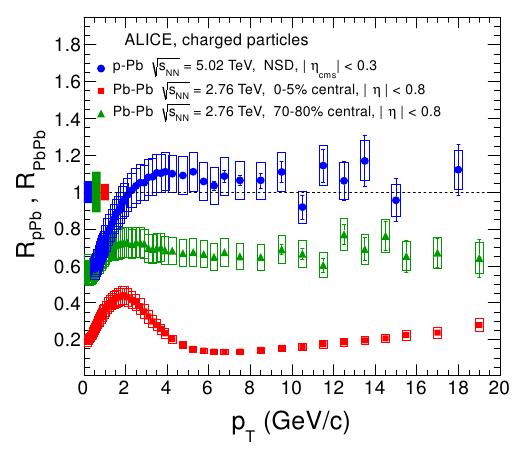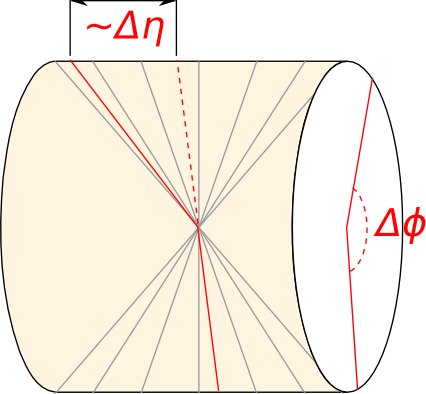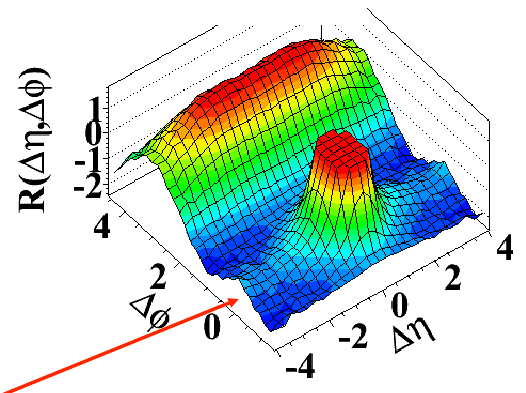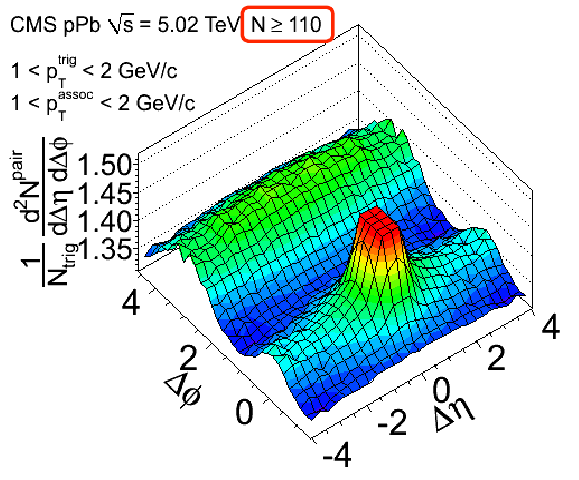Results from HPT 2012
Posted by David Zaslavsky on — CommentsOne unexpected perk of being in China: I woke up before 7:30 this morning. That would never happen without jet lag.
Unfortunately, even waking up at 7:30 every day hasn’t given me any time to write up a mid-conference blog post. Talks have been running from 8:30-6:30, with the rest of the time mostly taken up by meals and discussions. So I’ll just post this “teaser” of some of the more interesting results that were presented.
Of the presentations that gave new results, most of them are based the September proton-lead run at the LHC. This was just a pilot run, meant to ensure that there wouldn’t be any unexpected problems with colliding two different types of particles, so there wasn’t a lot of data collected — only 2 million collisions — but it was already enough to start shedding some light on the underlying physics.
No initial state effects
Ion-ion collisions have already been extensively studied at both RHIC and the LHC, and as you might imagine, when you smash a blob of a hundred blobs of particles into another blob of a hundred blobs of particles, what you get is a mess. But it’s an orderly mess, in a sense, one which physicists have managed to characterize as forming in several distinct stages. Roughly speaking: first, the ions approach and the individual partons (quarks and gluons) start to pass by each other, then they collide and form a blob of quark-gluon plasma (the “medium”), and finally the interactions within the medium produce hadrons that then have to make their way out of the QGP. Interactions between the partons in the first step are called initial state effects, and interactions between the hadrons and the medium in the last step are called final state effects.
(figure from Larry McLerran’s slides)
Now, from the results of ion-ion collisions at RHIC and also at the LHC, we know that final state effects do significantly affect what comes out to be detected. Jet quenching is the typical example: if a beam of reaction products (a jet) has to go through enough of the medium, it will be spread out into a weak “spray” rather than a strong jet. But there are other effects, less well understood, that make proton-proton collisions different from ion-ion collisions, and we can’t really tell whether or to what extent they are initial state effects or final state effects. Proton-ion collisions allow us to make that distinction because in a pA collision, there aren’t enough particles involved to form a final-state medium, so any difference between pp and pA must be due to initial state effects.
 This is where the results of the LHC’s pA run come in. ALICE has measured \(R_{pA}\), a way of characterizing the difference between proton-ion collisions and proton-proton collisions, and found it to be basically equal to 1 for high-momentum particles. That means the proton-ion collisions generate about as many particles as would be expected just by scaling up a proton-proton collision to the number of nucleons the projectile proton hits on its way through the ion, which in turn suggests that any initial-state effects are negligible.
This is where the results of the LHC’s pA run come in. ALICE has measured \(R_{pA}\), a way of characterizing the difference between proton-ion collisions and proton-proton collisions, and found it to be basically equal to 1 for high-momentum particles. That means the proton-ion collisions generate about as many particles as would be expected just by scaling up a proton-proton collision to the number of nucleons the projectile proton hits on its way through the ion, which in turn suggests that any initial-state effects are negligible.
The Ridge
Meanwhile, an interesting feature known simply as “the ridge” has been capturing everyone’s interest in proton-proton collisions. This takes a little bit of explanation, so bear with me.
When two protons collide with a large amount of energy, the individual parton collision will often produce two jets coming out in opposite directions, in the center-of-mass reference frame of the partons. However, those partons can have a net motion relative to the detector, in which case the jets will “inherit” that motion and will both emerge toward one direction or the other. This is essentially the same thing as relativistic beaming. However, this only affects the jets’ direction along the beam axis; they will always still be on opposite sides in the azimuthal direction \(\phi\).
 The standard way to visualize this is, for each event, to measure the difference in longitudinal coordinate, \(\Delta\eta\), and the difference in azimuthal coordinate, \(\Delta\phi\), between the jets, and make a histogram. When you do this, you get a peak at \((0,0)\) corresponding to the leading jet, and a hump at \(\Delta\phi = \pi\) spread out along all values of \(\Delta\eta\) corresponding to the subleading jet.
The standard way to visualize this is, for each event, to measure the difference in longitudinal coordinate, \(\Delta\eta\), and the difference in azimuthal coordinate, \(\Delta\phi\), between the jets, and make a histogram. When you do this, you get a peak at \((0,0)\) corresponding to the leading jet, and a hump at \(\Delta\phi = \pi\) spread out along all values of \(\Delta\eta\) corresponding to the subleading jet.
When this was actually done with the LHC proton-proton (pp) data for the collisions which produce the largest numbers of particles, in addition to the peak and hump, they also saw a bit of a ridge at \(\Delta\phi = 0\) for all values of \(\Delta\eta\), i.e. for jets coming out in the same transverse direction, but separated by an angle along the beam axis. This means there are a significant number of dijet events where the jets both come out on the same side of the detector, but not in the same direction!

Getting these results is interesting not only because these same-side jets require two partons to collide with a huge amount of transverse momentum, which is supposed to be fairly unusual, but also because any collision that involves that much transverse momentum you’d expect to produce two jets going in nearly the same direction. Clearly, that doesn’t always happen. This behavior is strange enough that nobody has a convincing explanation for what could be causing it.
To help pin down any possible causes of this ridge, the next natural step is to see whether it occurs in other circumstances, like proton-ion collisions (as opposed to two protons). And the new results presented at HPT 2012 show that it does! As with proton-proton collisions, the ridge shows up only in the collisions that produce the largest numbers of particles. Here’s the plot from CMS for collisions producing 110 or more particles:

This and the previous plot are taken from Gunther Roland’s presentation at the conference.
So what does this mean? In the immediate future, it means a lot of theorists get a chance to come up with a lot of crazy ideas in an attempt to explain this ridge :-P Seriously though, it means that something is going on in these heavy ion collisions, and consequently in the structure of atomic nuclei, which isn’t close to being covered by existing theories. The heavy-ion program at the LHC is definitely proving its worth.
